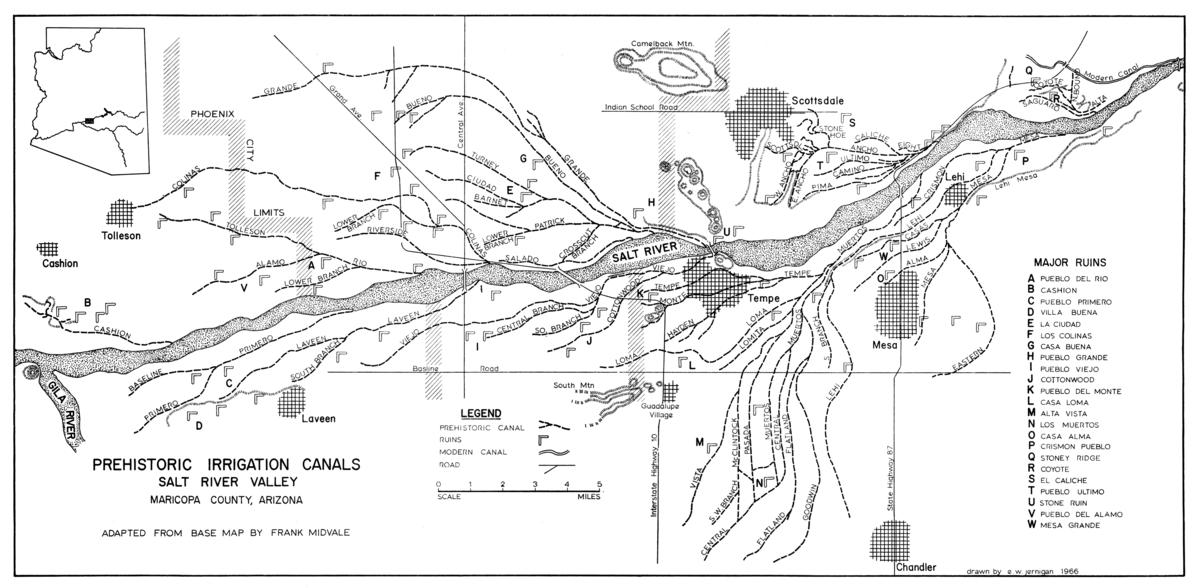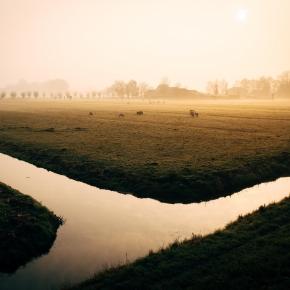

Today, while the word Hohokam is still accepted for the culture of these ancient people, the term is considered to be offensive in describing the people themselves, given that it is a butchering of an O’odham word. The Spanish called them the Hohokam, as their descendants, the O’odham, whom the Spanish met in 1694, referred to their ancestors using their word huhugam, meaning literally all ancestors of the people. Temperatures here can routinely exceed 110 degrees Fahrenheit in summer, and yet this civilization flourished for hundreds of years, vanishing for unknown reasons in the mid-1400s. (Trying to irrigate above the flood plains means starting canals at higher elevation to allow flow to reach these higher lands, meaning significantly longer channels begun much farther upstream, a sign archaeologists use to show the sophistication of the people creating them.) Over the next several hundred years, communities grew larger and were placed further from the rivers themselves as irrigation channels stretching dozens of miles were able to bring water even outside the river flood plains. The Ancestral Sonoran Desert People began to appear early in the first millennium CE, with settlements like this, replete with individual family dwellings, ball courts, and community constructions on man-made platforms appearing by the year 300 along the Salt and Gila Rivers. This hole only allows sun through during the solstice, leading some to believe the building was used for religious purposes. What we do know about the site comes from the descendants of those Ancestral Sonoran Desert People, tribes like the Pima and the Tohono O’odham. But those are all just guesses and nothing more. Some theories designate it a palace, or a trading center, even a religious temple as it has a hole in the back meant to let in the solstice sun. To this day, we don’t know what Casa Grande was used for. And it is impressive to me, certainly worth the hour’s drive from Phoenix. It was impressive enough to the new United States that in 1894, the area was set aside as the country’s very first archaeological reserve in an effort to prevent further vandalism of Casa Grande itself.


It was impressive enough to the Spanish that the 1775 overland exploration of Juan Bautista de Anza returned to the site to take specific measurements. It was constructed in a climate that most would find completely inhospitable to life in general, let alone a building project of this magnitude which, I must point out, still stands to this day despite the environment. It was built by hand, by a population numbering approximately five thousand rather than the millions living in Egypt, China, or Rome.
#Hohokam irrigation year series#
And so the huge populations of Eurasia were simply not possible.Ĭasa Grande, so named by the Spanish who first found it abandoned, along with the town around it, in 1694, was built of a sort of cement made of soil and clay mixed with water from the nearby Gila River, water funneled through a series of sophisticated irrigation canals for which the Ancestral Sonoran Desert People would come to be known. As such, Native American peoples had no ability to quarry and haul massive stones, no animals to assist in plowing fields, and no chance to diminish the need for human labor with that of large animals. North America had none prior to the arrival of Europeans and their cattle and horses. While his answers are diverse, one thing jumps out: domesticable animals. Jared Diamond, in his epic Guns, Germs, and Steel, discusses why some societies – largely Eurasian – developed technologically at more rapid paces than their counterparts elsewhere. And yet, in context, this seemingly insignificant building is every bit as impressive of a feat as those. Similarly, it was built nearly two thousand years after the Great Wall of China, and 1300 years after Rome’s Colosseum. Just how impressive is this? Casa Grande from belowĬasa Grande was built in about 1350 CE, nearly four millennia after the Pyramids of Egypt. The desert air here in central Arizona is dry and warm, and I circle the building to get views from each side. What makes a culture impressive? What makes a building project awe-inspiring or an engineering feat worthy of praise? Questions like these spiral through my head as I gaze at the ruins of Casa Grande, a four story building constructed by the Ancestral Sonoran Desert People.


 0 kommentar(er)
0 kommentar(er)
